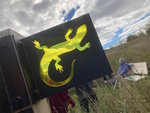, 0°
Wind: mph
The nature of the Upper Delaware River region lies at the heart of what makes it so truly special—pristine waters, clean air, forested landscapes with a rich diversity of flora and fauna. These priceless features draw truly special people into the communities here, people with deep connections to the natural world and a passion for protecting it.
Stay informed about your community and support local independent journalism.
Subscribe to The River Reporter today. click here
This item is available in full to subscribers.
Please log in to continue |


The nature of the Upper Delaware River region lies at the heart of what makes it so truly special—pristine waters, clean air, forested landscapes with a rich diversity of flora and fauna. These priceless features draw truly special people into the communities here, people with deep connections to the natural world and a passion for protecting it.
I was strongly reminded of this recently, during a ramble that began with a dedication ceremony in memory of Ed Wesely, the original River Talk writer and photographer, who handed off this column to me many moons ago. Ed was also a poet, with a passion for the work of Emily Dickinson.
The gathering took place at the new headquarters of the Delaware Highlands Conservancy, at the Van Scott Nature Reserve (delawarehighlands.org/vsnr/), where heartwarming tributes were offered in abundance. As a lifelong champion of the natural world, Ed’s dedication to its well-being never ceased.
After leaving the gathering, I enjoyed a meditative scenic drive along River Road in Pennsylvania, passing the sweet farmhouse where Ed and Barbara Yeaman lived along the Delaware River and planted the seeds for the land trust that since has conserved more than 18,000 acres throughout the region.
Along the way, I stopped to visit the resting place of my friend, the beloved award-winning children’s author and illustrator Vera B. Williams. Also a poet and dedicated activist, Williams worked hard to fend off fracking in the region, concerned about its impacts to animal, plant and human life; to water and air.
In a recording of Vera reading her poem, “Together Sing,” in which she encounters a small bird in the river birch that graces her porch, she confides:
“I fear that my people are driving us all to the edge.
You and I, you and I, you and I and all the others.
It could come about, little bird, that we humans have betrayed even ourselves,
Befouling beyond hope nest, cave, hole, house, burrow, earth, air, water, blood.”
Unexpectedly, Vera receives the gift of song from the delicate bird as it peers from the quivering leaves with its “apple-seed eye,” restoring her resolve.
“My heart relinquished its terror,” she concludes.
“Despair must not, can not, will not be our final song.”
A final example of the poetry of place provided the perfect ending to my river ramble, with a viewing of the latest installation at the Union Digital Gallery in Narrowsburg, NY. “Why Eye (I) Farm” shares the perspectives of regional farmers, featuring interviews by Rosie Starr and photography by Woody Goldberg. Don’t miss this thought-provoking, uplifting and inspiring work, which runs through October 30. (See more here.)
Fall is fading and light is dwindling as winter inches closer with every frost. Winter Solstice will occur on December 21, delivering the longest night and shortest day of the year. Light a candle against the encroaching dark and enjoy this sweet poem by Ed Wesley.
May winter sunbeams
kindle our thanks
to fellow creatures,
and gladden each of them.
Comments
No comments on this item Please log in to comment by clicking here